

Left/Top: ©Tuomas Lehtinen / Moment / Getty images.
Bottom/Right: © Zephyr18 / Getty Images Plus/Getty Images.
When it comes to laminate flooring versus hardwood, there are several key differences. Both are popular floor coverings, but each excels in different areas. Laminate is a good fit for basements, kids’ spaces, and moisture-prone rooms where hardwood will not perform well. Hardwood is a more expensive but higher-quality flooring than laminate, and it can usually lead to a higher resale value, especially when cared for properly.
In this article:
- What Is Hardwood Flooring?
- What Is Laminate Flooring?
- Appearance
- Cost
- Upkeep
- Durability
- Installation
- Lifespan
- Environmental Impact
- Resale Value
- Moisture Resistance
- Radiant Heating
- Pets
- Which Is Better for Your Home?
- Hardwood and Laminate vs. Other Materials
What Is Hardwood Flooring?
Producing hardwood starts with harvesting mature trees. It’s then milled, sanded, and either stained and finished in the factory or installed unfinished, then stained and sealed. There are many popular types of hardwood flooring, ranging in color from the pale blonde of white oak to the deep brown-black of ebony.
You can also choose different hardwood floor finishes, which can affect the floor’s performance in your home. For example, moisture-cured urethane is hardwearing and great for busy homes with pets and kids.
What Is Laminate Flooring?
Laminate is a synthetic composite product. It has a moisture-resistant stabilizing base layer topped with synthetic fiberboards that provide volume and strength. On top sits a photographic layer that gives the plank its design and color, along with a clear resin to make it more durable.
Appearance
Laminate flooring and wood often feature similar appearances. However, hardwood is known for its more organic, textural appearance.
| Hardwood | Laminate |
|---|---|
| Natural texture with unique grain patterns | Synthetic material that can mimic the look of hardwood |
| Can take on different stains and finishes | Many style possibilities extend beyond a hardwood appearance |
| Vulnerable to scratches and discoloration | Synthetic wood grain can look unrealistic on laminate |
Hardwood
Hardwood flooring is beloved for its warm, natural texture and unique grain patterns that ensure every hardwood floor is one of a kind. However, hardwood can scratch more easily than laminate and might fade or discolor when exposed to too much sun.
Laminate
Laminate can look like hardwood flooring depending on the photographic layer, but it doesn’t always look very realistic. Laminate also doesn’t offer the unique texture and look that hardwood offers. However, it can come in many different styles extending beyond wood.
Ready to start your flooring project?
Find ProsCost
It’s always a good idea to weigh laminate versus hardwood costs before making a decision. If you’re on a tight budget, laminate flooring is the better choice since it’s usually a fraction of the cost of hardwood flooring. However, hardwood usually lasts much longer than laminate, potentially saving you some money in the long run.
| Hardwood | Laminate |
|---|---|
| Costs between $6 – $12 per sq. ft. without installation | Costs between $0.70 – $2 per sq. ft. without installation |
| Exotic woods cost more than domestic | Price depends on the thickness and the quality of the print layer |
Hardwood
Hardwood flooring is typically much more expensive than laminate, ranging from $6 to $12 per square foot, not including installation. Exotic woods tend to cost the most, as do very strong types of wood. Refinishing hardwood floors costs between $3 and $8 per square foot
Laminate
Laminate flooring is definitely the budget-friendly choice compared to hardwood flooring. However, you can’t refinish damaged laminate flooring; you’ll have to replace it. Laminate flooring costs between $0.70 and $2 per square foot. Generally, thicker laminate with higher-quality print layers costs more than thinner laminate with lower-quality layers.
Upkeep
With high-quality finishes, laminate and hardwood are relatively easy to keep clean. However, each has advantages and disadvantages when it comes to maintenance.
| Hardwood | Laminate |
|---|---|
| Easy to clean by vacuuming or sweeping | Easy to clean with a light vacuuming |
| Refinishing is possible if it’s scratched | Requires replacement if damaged |
| Sensitive to moisture, so you can’t mop it with too much water | Can mop it with water |
| Cannot tolerate abrasive cleaners | Cannot tolerate standing water |
Hardwood
Hardwood is relatively easy to clean using a vacuum or broom. However, water can warp hardwood, so it’s best not to mop this flooring with lots of water. And while scratches can appear on hardwood, you can refinish them to remove the scratches rather than replacing the whole floor. You can also use furniture pads to help prevent scratches.
Laminate
Laminate is easy to clean with a vacuum, broom, and mop. It won’t typically warp when mopped with excessive water like hardwood. However, standing water can stain it, so it’s best to wipe up any spills as soon as they happen.
Durability
Both hardwood and laminate flooring do a good job of enduring lots of foot traffic for a period of time. However, hardwood is more prone to moisture damage, while laminate has a shorter lifespan.
| Hardwood | Laminate |
|---|---|
| Not as resistant to scratches, stains, and dents as laminate | Resistant to scratches, stains, and dents |
| Durability varies by species | You’ll have to replace damaged planks |
| Prone to moisture damage and warping if not sealed regularly | Standing water can cause it to warp |
| Too much sun exposure on certain species can cause discoloration | Less likely than some wood species to fade from sunlight but more likely to stain |
Hardwood
Hardwood flooring can last a lifetime, depending on the wood species and how well it’s maintained. And if it does start to deteriorate, hardwood flooring can often be refinished to restore its original appearance, unlike laminate, which needs replacing when damaged. Additionally, hardwood floors are more likely to fade from sunlight.
Repairing hardwood floors costs between $450 and $1,550, but it can go as high as $3,000 or more. Expect to pay $2 to $25 per square foot on average.
Laminate
Laminate flooring doesn’t last as long as hardwood, but it’s more resistant to scratches, stains, and dents. However, you will need to replace damaged planks rather than refinishing them. Laminate can also change appearance in the event of standing water, and it stains more easily than hardwood, so it’s best to clean up spills as soon as possible.
Prices to repair laminate flooring range from $360 to $1,790 but can go as high as $3,000. Repairs usually require removing and replacing damaged boards.
Installation
Whichever flooring material you choose, it’s best to hire a flooring contractor in your area to install it. But let’s take a closer look at the installation process for each.
| Hardwood | Laminate |
|---|---|
| More difficult to install than laminate | Easier for DIYers to install than hardwood |
| Prefinished hardwood flooring reduces installation time and cost | Comes prefinished, no need for sanding or sealing |
| Custom stains and finishes are available | Can emit volatile organic compounds that may negatively impact your health |
| Tongue-and-groove hardwood planks make DIY installation easier | Can be installed below grade and over existing floors |
| The dust and odor of the finish are not safe to inhale | New installations have strong scents that take days to dissipate |
Hardwood
Hardwood flooring is usually more challenging to install than laminate flooring, especially for DIYers. However, opting for tongue-and-groove hardwood planks can make installation easier. You can also choose prefinished hardwood flooring instead of unfinished if you want to reduce your installation time. This will also reduce installation costs if you hire a local hardwood flooring specialist to install it for you.
Laminate
Laminate is the easier of the two flooring types to install, and you can install laminate flooring over your existing floors or below grade. Laminate flooring also comes prefinished, so there’s no need to worry about sanding or sealing. However, you’ll need to be precise when cutting laminate plank flooring to ensure proper installation. Also, laminate might emit volatile organic compounds, which can pose a health risk.
Ready to start your flooring project?
Find ProsLifespan
One of hardwood flooring’s biggest benefits is that it can last a lifetime. Laminate, however, usually has a lifespan of 15 to 25 years.
| Hardwood | Laminate |
|---|---|
| Lasts 30 – 100 years | Lasts 15 – 25 years |
Hardwood
Hardwood flooring can last anywhere from 30 to 100 years or longer, depending on the wood species and how well it’s maintained. Also, you can often refinish it to extend its life rather than replacing it.
Laminate
Laminate flooring typically lasts 15 to 25 years when properly maintained. However, improper maintenance, like letting spills sit for extended periods, can reduce that lifespan considerably. Laminate flooring also can’t be refinished like hardwood, so once it loses its luster, you’ll have to replace it with new flooring.
Environmental Impact
When it comes to being eco-friendly, hardwood flooring is the better choice. However, many laminate floors are recyclable, slightly reducing their environmental impact.
| Hardwood | Laminate |
|---|---|
| More eco-friendly than laminate | Less eco-friendly than hardwood |
| Biodegradable | 85% of laminate flooring is recyclable |
Hardwood
Hardwood is among the few environmentally-friendly flooring choices, provided it’s sustainably sourced. This is largely because it’s recyclable and completely biodegradable, so it won’t contribute to the overflow of landfills.
Laminate
Since it’s a synthetic material that won’t biodegrade, laminate is decidedly less eco-friendly than hardwood flooring. However, around 85% of laminate flooring is recyclable, which minimizes its environmental impact. Additionally, most laminate flooring these days is LEED-certified. LEED certification indicates that the flooring manufacturer meets sustainability standards set by the U.S. Green Building Council.
Resale Value
Adding new flooring of any kind often boosts the resale value of your home. However, hardwood flooring tends to increase resale values more than laminate.
| Hardwood | Laminate |
|---|---|
| Higher resale value | Lower resale value |
| 54% of homebuyers would invest more in a home with hardwood flooring | Its shorter lifespan makes laminate less of a draw for potential homebuyers |
Hardwood
Due to their longer lifespan, hardwood floors usually offer a much higher resale value than laminate floors. In fact, 54% of homebuyers are willing to invest more money in a house if it has hardwood flooring.
Laminate
Due to its shorter lifespan, as well as its appearance compared to hardwood, laminate flooring won’t typically increase your resale value as much as hardwood flooring. However, it also costs much less to install.
Moisture Resistance
Even if you’re not installing new floors in a kitchen or bathroom, your floors will likely encounter moisture at some point, so it’s helpful to know how these materials tolerate water. When it comes to wood floors versus laminate, the latter tends to be more moisture-resistant.
| Hardwood | Laminate |
|---|---|
| The denser the wood, the more water-resistant it is | The top layer is moisture-resistant |
| Needs regular resealing to maintain moisture resistance | Standing water can damage it |
| Can grow mold if exposed to constant moisture | Less likely to develop mold than hardwood |
| Untreated wood is more susceptible to moisture damage | Water can seep in and damage the boards underneath if the seal and top layer are damaged |
Hardwood
Hardwood flooring requires regular sealing to ensure it’s resistant to moisture. But even when sealed, it’s generally more vulnerable to moisture damage than laminate, so you shouldn’t mop this flooring with a lot of water. Opting for a dense wood species will give you better moisture resistance.
Laminate
The top layer of laminate flooring is more resistant to moisture than hardwood. Laminate flooring is also less likely to develop mold than its hardwood counterpart. However, standing water can cause laminate flooring to bubble and warp. And if the floor’s top layer is damaged, water can seep underneath and damage the floorboards.
Radiant Heating
In colder climates, radiant heating can keep your home comfortably warm. But hardwood flooring tends to be better for radiant heating systems than laminate. Laminate or hardwood radiant floor heating costs about $15 to $20 per square foot.
| Hardwood | Laminate |
|---|---|
| Thin boards are better for radiant heat than thick boards | Radiant heating requires specialized laminate |
| Best to use a wood species that can adapt to humidity changes | Often doesn’t conduct heat efficiently |
Hardwood
In general, hardwood flooring is better than laminate flooring when it comes to radiant heating since it’s better at distributing heat. However, you want to make sure you choose a wood species that can adapt well to humidity changes. Thinner hardwood planks are also better at distributing radiant heat than thicker planks.
Laminate
You usually need specialized laminate flooring for radiant heating. But even specialized laminate won’t work as well with radiant heating as hardwood floors. Laminate doesn’t do a great job of conducting heat, and temperature changes can cause it to expand and shrink, creating gaps in the floor.
Ready to start your flooring project?
Find ProsPets
Pets and their little toenails can take a toll on your flooring. If you have four-legged family members running around your house, consider the advantages and disadvantages of these two flooring types.
| Hardwood | Laminate |
|---|---|
| Provides better traction for pets than laminate | More resistant to scratches than hardwood |
| Easy to clean | Also easy to clean |
| Can refinish scratches | Pet waste can soak into the floor and cause odors |
| Spilled water bowls could cause moisture damage | More slippery for pets than hardwood |
| Hardwood floors can sound loud if pets race around | Pets’ toenails won’t sound as loud on laminate compared to hardwood |
Hardwood
Hardwood flooring is more likely to get scratched from your pet’s toenails than laminate. However, you can remove scratches by refinishing the floor without needing to replace it. Hardwood also provides better traction for pets, making it easier for them to walk and run around. But little pet steps tend to sound louder on hardwood than laminate.
Laminate
Laminate flooring won’t scratch as easily when little toenails run across it as hardwood, but when it does get scratched, you can’t refinish it. Your pets might also have a harder time walking and running on laminate since it’s more slippery. And when your pet spills their water bowl, and you can’t clean it right away, the water can warp the floor, but this is also true for hardwood.
Is Laminate Flooring or Hardwood Flooring Better for Your Home?
Laminate and hardwood are both viable flooring options for your home. The right choice depends on your priorities, such as price, look, and durability.
| Factor | Hardwood | Laminate |
|---|---|---|
| Appearance | Natural look | Manufactured look |
| Cost | $6 – $12 per square foot | $0.70 – $2 per square foot |
| Lifespan | 30 – 100+ years | 15 – 25 years |
| Installation | Harder to install | Easier to install |
| Environmental Impact | Biodegradable and recyclable | Not biodegradable but often recyclable |
| Durability | More durable | Less durable |
| Radiant Heating | Best for radiant heating | Not ideal for radiant heating |
| Resale Value | Higher resale value | Lower resale value |
| Moisture Resistance | Less moisture resistant | More moisture resistant |
For Bathroom Flooring
In the bathroom, laminate flooring is the better choice as it’s better at resisting moisture than hardwood and doesn’t require extra sealing or special precautions. For other flooring options for this room, check out the best bathroom flooring materials.
For Kitchen Flooring
For kitchens, hardwood is preferable to laminate. If properly sealed, it’s durable, warm, and beautiful. Hardwood is also easy to keep clean and less slippery than laminate, and it’s better for radiant heating. Just be sure to wipe away spills quickly to avoid moisture damage.
There are various kitchen wood flooring types, including reclaimed wood planks, solid unfinished or prefinished planks, and specific wood species, like hickory, oak, ash, maple, and cherry.
For Living Room Flooring
Hardwood is an excellent choice for living rooms. The living room is usually the biggest, most-used room in the home, so if you spend money anywhere, this is a good room to invest in. Hardwood is attractive, comfortable to walk on, and can provide your living room with lots of welcoming warmth.
For High-Traffic Areas
High-traffic areas need floors that can endure regular use. Choose laminate for bathrooms and utility areas that withstand lots of wear—muddy boots and wet laundry won’t impact good laminate. Hallways and other high-traffic areas might benefit from dense, durable hardwood like ebony or Brazilian cherry. These woods are hard enough to withstand a lot of foot traffic yet beautiful enough to add value to your property and leave a good impression on visitors.
Hardwood and Laminate vs. Other Materials
There are many types of residential flooring, with hardwood and laminate being two of the most popular. Let’s see how they stack up against other wood-look floorings.
Engineered wood flooring costs less than laminate but is on par with hardwood. While not solid wood, engineered wood flooring does have a thin veneer of natural wood laid over a dense plywood or fiberboard base. Good quality planks are indistinguishable from solid hardwood. They’re also suitable for use with radiant heat. Unlike laminate, you can usually refinish it a couple of times, but it still doesn’t have the longevity of solid hardwood floors.
Vinyl floors cost about the same as laminate. While it looks like wood, vinyl can mimic tile or stone or have completely different designs. It won’t add long-term value to your home, but vinyl is a great budget-friendly choice that is moisture-resistant, comparatively simple to install, and easy to clean.
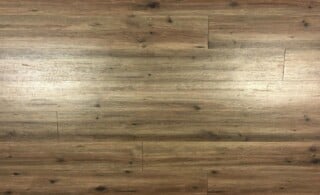 Engineered Wood Floors vs. Laminate Floors: What’s the Difference?
Engineered Wood Floors vs. Laminate Floors: What’s the Difference? 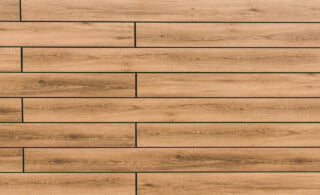 Laminate Floor vs. Vinyl: Which Is Better for Your Home?
Laminate Floor vs. Vinyl: Which Is Better for Your Home? 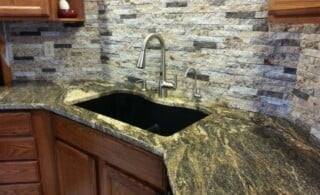 Corner Bathroom and Kitchen Sinks
Corner Bathroom and Kitchen Sinks 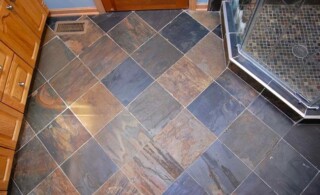 Guide to Repairing a Bathroom Floor
Guide to Repairing a Bathroom Floor 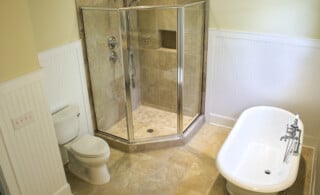 Is It Possible to Level a Bathroom Floor?
Is It Possible to Level a Bathroom Floor? 

Your article doesn’t delve into the third item you offered. Need more details on “engineered hard wood ” pros and can cons,best manufacturer etc.
Hey Robert
Thanks for the feedback. We’re currently working on more of these material comparison guides now. Look out for an article comparing engineered wood and laminate soon. Thanks for your patience!
Yes I would like to see the comparison of laminate to engineered hardwoods as well. Looking forward to it.
I also am looking for flooring comparisons regarding engineered wood vs laminate. Flooring is an expensive adventure. The more information the better. Thank you for your knowledge, advise and input!
Where to start with updates????? So, my house is about 15 years old and I’ve been living in it for the last 10 years. It’s time to start doing some updates, but I can’t do everything at once. I’m a dog owner, and the carpets are shot, so replacing the carpets and lanolin floors with a new flooring solution is a must. However I also want to update the cabinets, replace the counter-tops, and add a back-splash. Upstairs I want to do the same (minus the back-splash), as well as tile around the showers and tubs. There’s a ton to be done! However, I know there has to be a logically order to start since once update will impact the next, and the next. Where should I start first, and what should be the “update sequence”?
need pricing for sub-flooring only putting laminate flooring down floors were measured came back uneven so need toput new sub flooring in can you give me some prices for this project
House came with lots of Marmoleum (sp.?) flooring. Question: replace (or not) with wood/laminate etc.?
Sub-flooring needs to be addressed as well as comparison of laminate to engineered wood
I am no expert but worked with a stained concrete contractor for a while. If I was doing your project (reference David Dodson’s question). I would do floors last as they will get destroyed by other contractors. I would pull up all the material on the floor do all of the cabinets and countertops then finish with flooring. I can’t tell you how many times we used Ramboards to protect the floors and they would tear them to get to something and we would have to redo the flooring. Also use this sequence when working the patio outside and have a pool. Get the pool all done then always do floors last. Have fun DIYing!